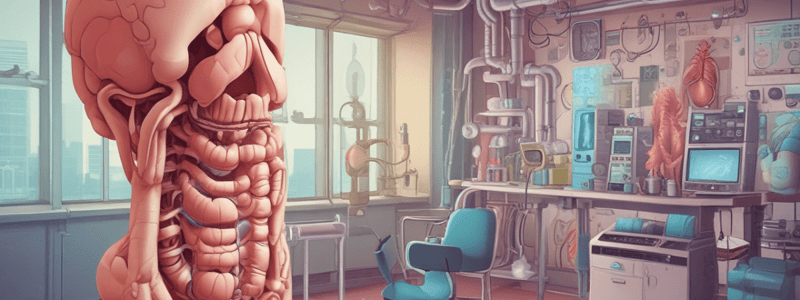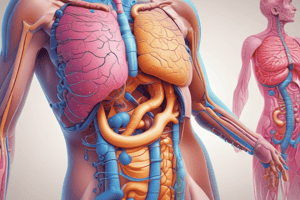Podcast
Questions and Answers
What is the primary propulsion force that drives food through the GI tract?
What is the primary propulsion force that drives food through the GI tract?
- Voluntary muscle movement
- Gravity
- Involuntary muscular contraction (correct)
- Involuntary nervous stimulation
What is the primary function of the submucosa layer in the GI tract?
What is the primary function of the submucosa layer in the GI tract?
- Absorption of nutrients
- Support and structure for the mucosa (correct)
- Secretion of digestive enzymes
- Muscular contraction and relaxation
What is the primary site of nutrient absorption in the GI tract?
What is the primary site of nutrient absorption in the GI tract?
- Liver
- Stomach
- Mouth
- Intestine (correct)
What is the function of hormones released by endocrine cells in the GI epithelium?
What is the function of hormones released by endocrine cells in the GI epithelium?
What is the function of salivary and gastrointestinal fluid secretions in the GI tract?
What is the function of salivary and gastrointestinal fluid secretions in the GI tract?
What is the function of the enterohepatic circulation in the GI tract?
What is the function of the enterohepatic circulation in the GI tract?
What is the primary site of initial digestion of food in the GI tract?
What is the primary site of initial digestion of food in the GI tract?
What is the fate of salivary and gastrointestinal fluid secretions in the GI tract?
What is the fate of salivary and gastrointestinal fluid secretions in the GI tract?
What is the primary function of the smooth muscles in the muscularis mucosae?
What is the primary function of the smooth muscles in the muscularis mucosae?
Which of the following is NOT part of the four concentric layers of the gastrointestinal tract?
Which of the following is NOT part of the four concentric layers of the gastrointestinal tract?
What is the role of Messner's plexus in the digestive tract?
What is the role of Messner's plexus in the digestive tract?
Which secretion from the liver assists with digestion in the small intestine?
Which secretion from the liver assists with digestion in the small intestine?
In which part of the digestive tract does the majority of carbohydrate and amino acid absorption take place?
In which part of the digestive tract does the majority of carbohydrate and amino acid absorption take place?
What distinguishes the upper esophagus and anal sphincter from other parts of the muscularis externa?
What distinguishes the upper esophagus and anal sphincter from other parts of the muscularis externa?
What type of connective tissue is primarily found in the lamina propria of the mucosa?
What type of connective tissue is primarily found in the lamina propria of the mucosa?
What is the main purpose of the muscular valves or sphincters in the gastrointestinal tract?
What is the main purpose of the muscular valves or sphincters in the gastrointestinal tract?
What is the primary role of parietal cells in the gastric gland?
What is the primary role of parietal cells in the gastric gland?
What stimulates the secretion of histamine from enterochromaffin-like cells?
What stimulates the secretion of histamine from enterochromaffin-like cells?
Which hormone is released by G cells and plays a role in stimulating parietal cells?
Which hormone is released by G cells and plays a role in stimulating parietal cells?
How does PGE2 affect gastric acid secretion?
How does PGE2 affect gastric acid secretion?
What is the primary function of chief cells in the gastric gland?
What is the primary function of chief cells in the gastric gland?
What is a key structural feature of parietal cells that aids in their function?
What is a key structural feature of parietal cells that aids in their function?
What mediates the potentiation of acid secretion by parietal cells?
What mediates the potentiation of acid secretion by parietal cells?
What is the diameter of parietal cells in the gastric gland?
What is the diameter of parietal cells in the gastric gland?
Which mechanism primarily contributes to the secretion of gastric acid in Zollinger-Ellison Syndrome?
Which mechanism primarily contributes to the secretion of gastric acid in Zollinger-Ellison Syndrome?
What is the typical pH range observed in the jejunum of patients with Zollinger-Ellison Syndrome?
What is the typical pH range observed in the jejunum of patients with Zollinger-Ellison Syndrome?
Which cellular component predominates in the exocrine function of the pancreas?
Which cellular component predominates in the exocrine function of the pancreas?
What role does pepsinogen play in the pathophysiology of Zollinger-Ellison Syndrome?
What role does pepsinogen play in the pathophysiology of Zollinger-Ellison Syndrome?
Which part of the pancreas is predominantly drained by the main pancreatic duct?
Which part of the pancreas is predominantly drained by the main pancreatic duct?
What is the primary factor leading to diarrhea in patients with Zollinger-Ellison Syndrome?
What is the primary factor leading to diarrhea in patients with Zollinger-Ellison Syndrome?
Which characteristic is true of the pancreas's endocrine tissue?
Which characteristic is true of the pancreas's endocrine tissue?
What type of nervous system innervation primarily influences pancreatic secretion?
What type of nervous system innervation primarily influences pancreatic secretion?
What effect does atropine have on saliva and blood flow?
What effect does atropine have on saliva and blood flow?
What is the primary mechanism that leads to increased salivary secretion?
What is the primary mechanism that leads to increased salivary secretion?
Which electrolytes are involved in the modification of primary saliva in the striated duct system?
Which electrolytes are involved in the modification of primary saliva in the striated duct system?
What role does the Na+-K+-2Cl- co-transporter play in salivary secretion?
What role does the Na+-K+-2Cl- co-transporter play in salivary secretion?
What happens to Cl- conductance when the stimulation of salivary secretion stops?
What happens to Cl- conductance when the stimulation of salivary secretion stops?
What initiates the release of neurotransmitters and hormones in the salivary secretion mechanism?
What initiates the release of neurotransmitters and hormones in the salivary secretion mechanism?
In the context of salivary secretion, what is the significance of K+ channels on the basolateral membrane?
In the context of salivary secretion, what is the significance of K+ channels on the basolateral membrane?
Which of the following stimuli does NOT contribute to salivary secretion?
Which of the following stimuli does NOT contribute to salivary secretion?
Flashcards are hidden until you start studying
Study Notes
Overview of the Digestive System
- The gastrointestinal (GI) tract comprises four main layers: serosa, muscularis externa, submucosa, and mucosa.
- Functions of GI tract layers include protection, absorption, and motility regulation.
Functions of Salivary, Gastric, and Pancreatic Secretions
- Salivary secretions start digestion with enzymes like amylase that break down carbohydrates.
- Gastric secretions, including HCl from parietal cells, facilitate protein digestion and create an acidic environment for pepsin activation.
- Pancreatic secretions, rich in digestive enzymes, enter the small intestine, where they further aid in nutrient breakdown.
Regulation of Digestion and Absorption
- Digestion begins in the mouth and continues in the stomach; primary absorption of nutrients occurs in the small intestine.
- Endocrine cells in the GI epithelium, like G cells, release hormones (e.g., gastrin) to modulate digestive activity.
Mechanisms of Bile Secretion and Enterohepatic Circulation
- Bile secretion is regulated by hormonal signals from the intestine, primarily cholecystokinin (CCK).
- Enterohepatic circulation involves the recycling of bile acids from the intestine back to the liver.
Histological Organization of the GI Tract
- The GI tract, from esophagus to large intestine, consists of four concentric layers: mucosa, submucosa, muscularis externa, and serosa/adventitia.
- Mucosa includes epithelium, lamina propria (connective tissue), and muscularis mucosae, enabling absorption and secretion.
- Submucosa contains blood vessels, lymphatics, and neural plexus (Meissner's plexus) for regulation of the GI tract's functions.
Salivary Secretory Mechanisms
- Saliva formation occurs in a two-step process starting with isotonic primary fluid produced by acinar cells, modified in the ducts.
- Salivary secretion is stimulated by sensory input like taste or smell, regulated by both parasympathetic and sympathetic nerves.
Gastric Acid Secretion Regulation
- HCl secretion in the stomach is mediated by gastrin, histamine, and acetylcholine acting on parietal cells.
- Histamine from enterochromaffin-like cells plays a central role in stimulating gastric acid secretion.
- Prostaglandin E2 (PGE2) inhibits gastric acid secretion by blocking histamine's action.
Zollinger-Ellison Syndrome (ZES)
- ZES is characterized by gastrin-secreting tumors (gastrinomas) in the pancreas or duodenum, leading to excessive gastric acid production.
- Symptoms include peptic ulcers and diarrhea due to increased gastric acidity and pepsinogen conversion to active pepsin.
Regulation of Pancreatic Secretion
- The pancreas, approximately 90-100 g in weight, serves as a mixed endocrine and exocrine gland, primarily composed of acinar cells.
- The main pancreatic duct drains digestive secretions into the duodenum, where they participate in nutrient digestion.
- Pancreatic acini contain zymogen granules filled with digestive enzymes, responsible for significant digestive activity in the small intestine.
Studying That Suits You
Use AI to generate personalized quizzes and flashcards to suit your learning preferences.



